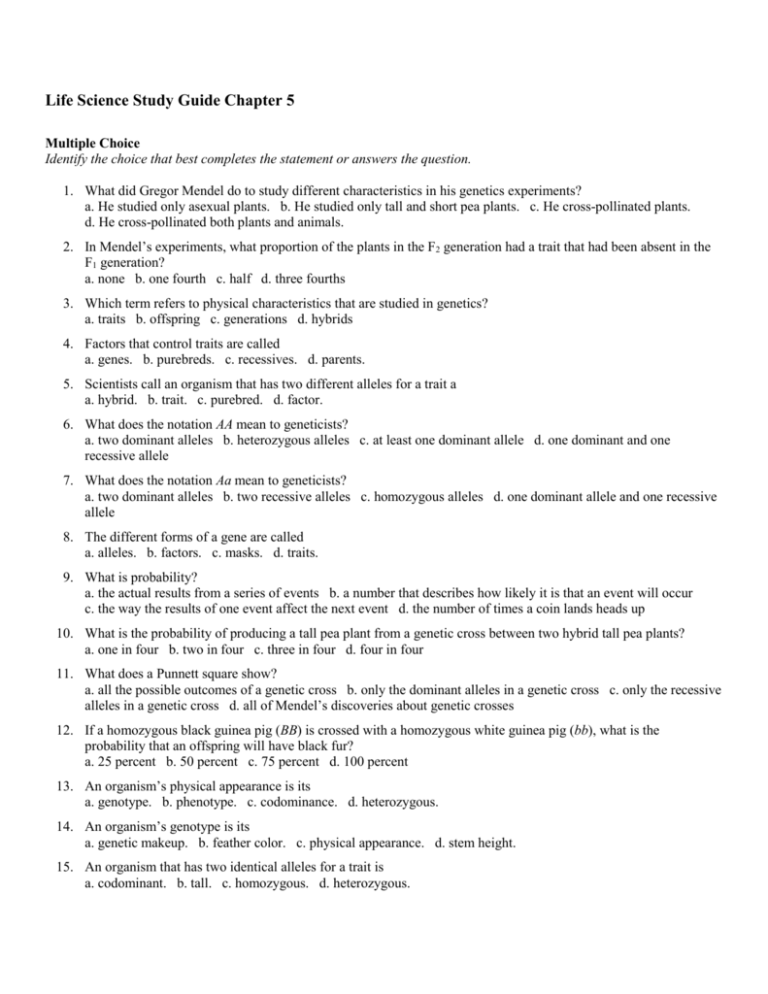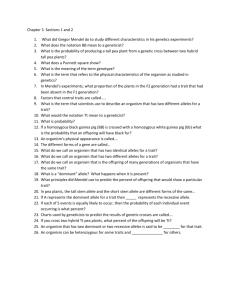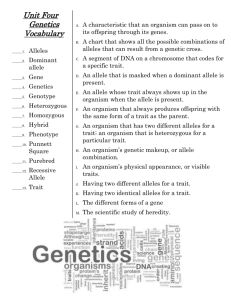Life Science Chapter 5 Study Guide
advertisement

Life Science Study Guide Chapter 5 Multiple Choice Identify the choice that best completes the statement or answers the question. 1. What did Gregor Mendel do to study different characteristics in his genetics experiments? a. He studied only asexual plants. b. He studied only tall and short pea plants. c. He cross-pollinated plants. d. He cross-pollinated both plants and animals. 2. In Mendel’s experiments, what proportion of the plants in the F2 generation had a trait that had been absent in the F1 generation? a. none b. one fourth c. half d. three fourths 3. Which term refers to physical characteristics that are studied in genetics? a. traits b. offspring c. generations d. hybrids 4. Factors that control traits are called a. genes. b. purebreds. c. recessives. d. parents. 5. Scientists call an organism that has two different alleles for a trait a a. hybrid. b. trait. c. purebred. d. factor. 6. What does the notation AA mean to geneticists? a. two dominant alleles b. heterozygous alleles c. at least one dominant allele d. one dominant and one recessive allele 7. What does the notation Aa mean to geneticists? a. two dominant alleles b. two recessive alleles c. homozygous alleles d. one dominant allele and one recessive allele 8. The different forms of a gene are called a. alleles. b. factors. c. masks. d. traits. 9. What is probability? a. the actual results from a series of events b. a number that describes how likely it is that an event will occur c. the way the results of one event affect the next event d. the number of times a coin lands heads up 10. What is the probability of producing a tall pea plant from a genetic cross between two hybrid tall pea plants? a. one in four b. two in four c. three in four d. four in four 11. What does a Punnett square show? a. all the possible outcomes of a genetic cross b. only the dominant alleles in a genetic cross c. only the recessive alleles in a genetic cross d. all of Mendel’s discoveries about genetic crosses 12. If a homozygous black guinea pig (BB) is crossed with a homozygous white guinea pig (bb), what is the probability that an offspring will have black fur? a. 25 percent b. 50 percent c. 75 percent d. 100 percent 13. An organism’s physical appearance is its a. genotype. b. phenotype. c. codominance. d. heterozygous. 14. An organism’s genotype is its a. genetic makeup. b. feather color. c. physical appearance. d. stem height. 15. An organism that has two identical alleles for a trait is a. codominant. b. tall. c. homozygous. d. heterozygous. 16. A heterozygous organism has a. three different alleles for a trait. b. two identical alleles for a trait. c. only one allele for a trait. d. two different alleles for a trait. 17. A purebred chicken with white feathers is crossed with a purebred chicken that has black feathers. Each of their offspring has both black and white feathers. Why does this happen? a. Both alleles for feather color are dominant. b. Both alleles for feather color are recessive. c. The alleles for feather color are neither dominant nor recessive. d. Several alleles work together to determine the trait. 18. What is the chromosome theory of inheritance? a. Chromosomes are carried from parents to offspring on hybrids. b. Genes are carried from parents to offspring on chromosomes. c. Hybrid pairs of chromosomes combine to form offspring. d. Codominant genes combine to form new hybrids. 19. Walter Sutton discovered that the sex cells of grasshoppers have a. 12 times the number of chromosomes found in the body cells. b. twice the number of chromosomes found in the body cells. c. the same number of chromosomes found in the body cells. d. half the number of chromosomes found in the body cells. 20. What happens during meiosis? a. Two sex cells combine. b. Chromosome pairs separate and are distributed into new sex cells. c. Each sex cell copies itself to form four new chromosomes. d. Chromosome pairs remain together when new sex cells are formed. 21. When sex cells combine to produce offspring, each sex cell will contribute a. one fourth the number of chromosomes in body cells. b. half the number of chromosomes in body cells. c. the normal number of chromosomes in body cells. d. twice the number of chromosomes in body cells. 22. Chromosomes are made up of a. one pair of alleles. b. many traits joined together. c. transfer RNA. d. many genes joined together. 23. What determines the genetic code? a. the order of nitrogen bases along a gene b. the number of nitrogen bases in a DNA molecule c. the order of amino acids in a protein d. the number of guanine and cytosine bases in a chromosome 24. The order of the bases along a gene determines the order in which a. sugars are put together to form a carbohydrate. b. phosphates are arranged in DNA. c. amino acids are put together to form a protein. d. chromosomes are arranged in the nucleus. 25. What does messenger RNA do during protein synthesis? a. copies the coded message from the DNA and carries it into the cytoplasm b. copies the coded message from the DNA and carries it into the nucleus c. carries amino acids and adds them to the growing protein d. copies the coded message from the protein and carries it into the nucleus 26. What do transfer RNA molecules do during protein synthesis? a. copy the coded message from the protein and carry it into the nucleus b. copy the coded message from the DNA and carry it into the nucleus c. carry amino acids and add them to the growing protein d. copy the coded message from the DNA and carry it into the cytoplasm 27. Where does protein synthesis take place? a. in the ribosomes in the nucleus of the cell b. on the ribosomes in the cytoplasm of the cell c. in the chromosomes in the nucleus of the cell d. on the chromosomes in the cytoplasm of the cell 28. Which nitrogen base in RNA is NOT part of DNA? a. adenine b. guanine c. cytosine d. uracil 29. What is a mutation? a. any change that is harmful to an organism b. any change in a gene or chromosome c. any change that is helpful to an organism d. any change in the phenotype of a cell 30. A mutation is harmful to an organism if it a. changes the DNA of the organism. b. changes the phenotype of the organism. c. reduces the organism’s chances for survival and reproduction. d. makes the organism better able to avoid predators. Modified True/False Indicate whether the statement is true or false. If false, change the identified word or phrase to make the statement true. 31. When Mendel crossed purebred short plants with purebred tall plants, all of the offspring were short. _________________________ 32. A hybrid is the offspring of parents that have different alleles for a trait. _________________________ 33. A pea plant that is heterozygous for tall stems has the alleles Tt. _________________________ 34. A Punnett square shows all the possible combinations of alleles resulting from a cross. _________________________ 35. An organism’s phenotype is its allele combinations. _________________________ 36. Chromosomes carry genes from parents to offspring. _________________________ 37. The sex cells produced by meiosis have twice the number of chromosomes as the parent cells. _________________________ 38. The number of DNA bases along a gene specifies the type of protein that will be produced. _________________________ 39. Transfer RNA carries coded messages from the nucleus to the cytoplasm. _________________________ 40. A mutation in a sex cell can be passed to offspring. _________________________ Completion Complete each statement. 41. A(n) ____________________ organism is the offspring of many generations of organisms that have the same trait. 42. If a(n) ____________________ allele is present, its trait will appear in the organism. 43. In pea plants, the tall-stem allele and the short-stem allele are different forms of the same ____________________. 44. If D represents the dominant allele of a gene, then ____________________ represents the recessive allele. 45. Mendel used the principles of ____________________ to predict what percent of offspring would show a particular trait. 46. If each of ten events is equally likely to occur, the probability of each individual event occurring is ____________________ percent. 47. A chart used to predict results of genetic crosses is known as a(n) ____________________. 48. In a cross between two hybrid Tt pea plants, ____________________ percent of the offspring will be Tt. 49. An organism that has two dominant or two recessive alleles is said to be ____________________ for that trait. 50. Alleles that are neither dominant nor recessive produce an inheritance pattern known as ____________________. 51. Genes are carried from parents to their offspring on structures called ____________________. 52. The process in which a parent cell divides twice to produce sex cells is called ____________________. 53. If all of the sex cells of an organism have the T allele, the genotype of that organism must be ____________________. 54. An organism can be heterozygous for some traits and ____________________ for others. 55. The chromosomes in a pair may each have different ____________________ for each gene. 56. The genetic code is found in the order of nitrogen ____________________ along a gene. 57. A set of three bases codes for one specific ____________________ in a protein. 58. ____________________ RNA adds amino acids to a growing protein. 59. A section of DNA has the base sequence TGAG. The corresponding section of a messenger RNA molecule will have the base sequence ___________________. 60. The substitution of one base for another during DNA replication is an example of a(n) ____________________. Short Answer Use the diagram to answer each question. 61. Which trait—white flowers or purple flowers—is controlled by a dominant allele? Which is controlled by a recessive allele? How do you know? 62. In which generation are the parents purebred? In which generation are they hybrids? 63. In the F2 generation, what percent of the offspring have purple flowers? What is the genotype of the purpleflowered offspring? 64. In the F2 generation, what percent of the offspring have white flowers? What are the genotypes of the whiteflowered offspring? 65. Suppose one of the parents of the F2 generation had been ww instead of Ww. What percent of the offspring would have purple flowers? What percent would have white flowers? 66. In the F1 generation, what is the genotype of the offspring? What is their phenotype? Use the diagram to answer each question. 67. Identify structure A and state what it is made of. 68. Identify structures B and C. 69. Identify structure D and state where it is made. 70. Identify structure E and describe its function. 71. What are the three nitrogen bases in transfer RNA that pair with bases A-G-U in messenger RNA? 72. If one of the nitrogen bases on structure D were replaced by a different base, what effect might that have on protein synthesis? Essay 73. Explain why Mendel’s cross of purebred tall and short pea plants resulted in only tall plants. 74. In pea plants, green pod color is controlled by a dominant allele. Yellow is controlled by a recessive allele. Explain why a plant with yellow pods can never be a hybrid. 75. A woman gives birth to a son. Two years later, she gives birth to another son. What is the probability that her third child will be a girl? Explain your reasoning. 76. In pea plants, the allele for smooth pods (S) is dominant over the allele for pinched pods (s). Construct a Punnett square that shows a cross between an SS plant and an Ss plant. Predict what percent of the offspring are likely to have smooth pods. 77. Some clover plants have leaves with a white stripe. Other clover plants have leaves with a white spot. When these two types of plants are crossed, the leaves of the offspring have a white stripe and a white spot. Explain how this inheritance pattern occurs. 78. Explain the function of meiosis. 79. Describe what messenger RNA and transfer RNA do during protein synthesis. 80. Contrast the effects of harmful and helpful mutations.








